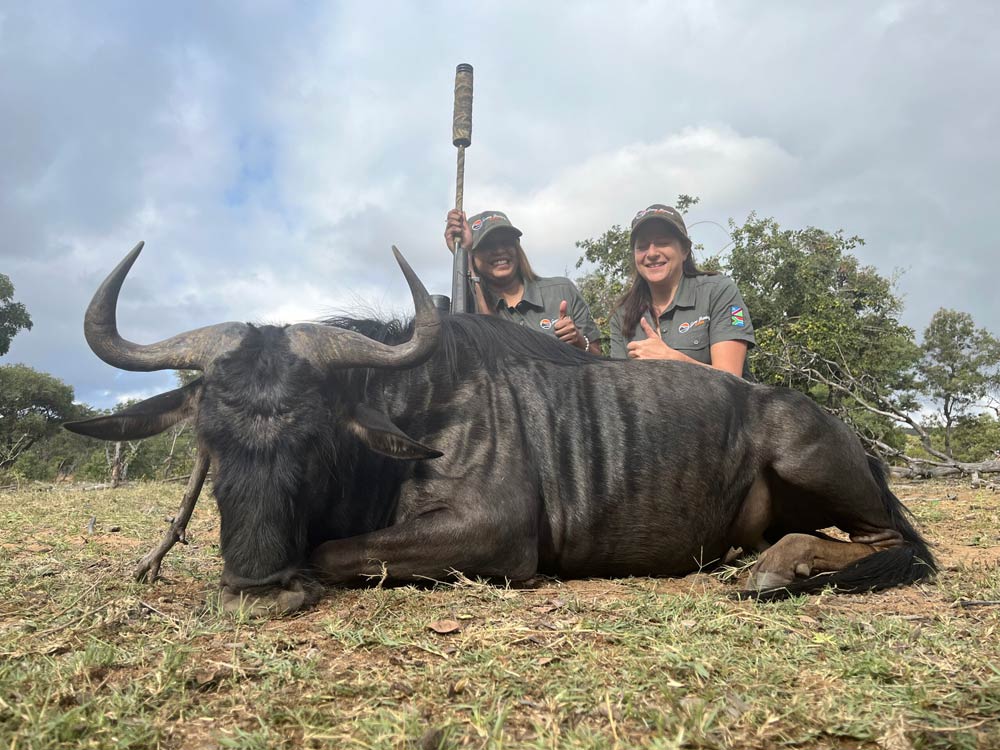So, with great excitement we packed the vehicle and started out on our 2 hour journey to Limpopo. My friend Sam had never been on an africa plains game hunt and had actually never hunted before so we had deep conversations on the way. Travelling to Limpopo is mostly on the highway and there are a few toll gates that we had to pass through on the way. The toll gates do get rather busy if there is a public holiday and this needs to be taken into account when travelling. However, we had no traffic issues. The Highway we traveled on is known as the N1 and is very well maintained (no potholes) with traffic police at regular intervals ensuring that everyone adheres to the speed limit. This route is also rather scenic, and you pass fenced ranched with open veld and sunflower or maize crops (depending on the season). You will also see many cows but if you are lucky, you will see some Kudu or Nyala.
[DYNAMIC-BLOGTABLEOFCONTENT]
Is it safe traveling by car from OR Tambo airport to Limpopo?
Yes, it is safe to travel from Oliver Tambo to Limpopo in South Africa.
If you are travelling from the airport, you will take the same route that we did and as mentioned above it is very safe and quite scenic. We have written about safety in some of our other blogs.
Is there a place to stop for basic supplies?
Yes, there are a number of gas stations along the way. We made a petrol stop along the way to Limpopo and the gas stations along this route will cater to almost anything you may have forgotten. The gas stations are clean, and the attendants are friendly (in SA you do not pump your own gas, the government dictates that petrol attendants must be employed to pump gas – thereby creating employment).
There are fast food outlets here and you can grab a burger, fried chicken, cold drink or a decent coffee. It was early in the morning, and we opted for a good hot coffee.
Each gas station has its own convenience store, and you can pack snacks for the road colloquially known as “padkos” the direct translation is road food and is certainly not to be confused with road kill. Seriously though there is a wide variety of snacks available, and they also stock a South African staple snack we call Biltong which is similar to Jerky but much much better. Biltong is made from various animals beef and Kudu being the most popular but is made from almost any game animal. Biltong is also available in the various drying stages, this means you can buy “wet biltong” which has a moist soft center and has been dried for the shortest period, “moist biltong” which has hung a little longer and has a tougher exterior but the center is still a little soft and then “dry biltong” which has been completely dried and is hard all the way through. They are all good it just depends on your preference.
Gas stations will also stock almost any brand of cigarette so if you are a smoker (like me) you will be able to stock up and for the ladies, they also stock feminine hygiene products and things like antacid and plasters.
So, after our coffee and stocking up on supplies we made a quick stop at the restrooms which are also kept clean and hygienic and then went on our way.
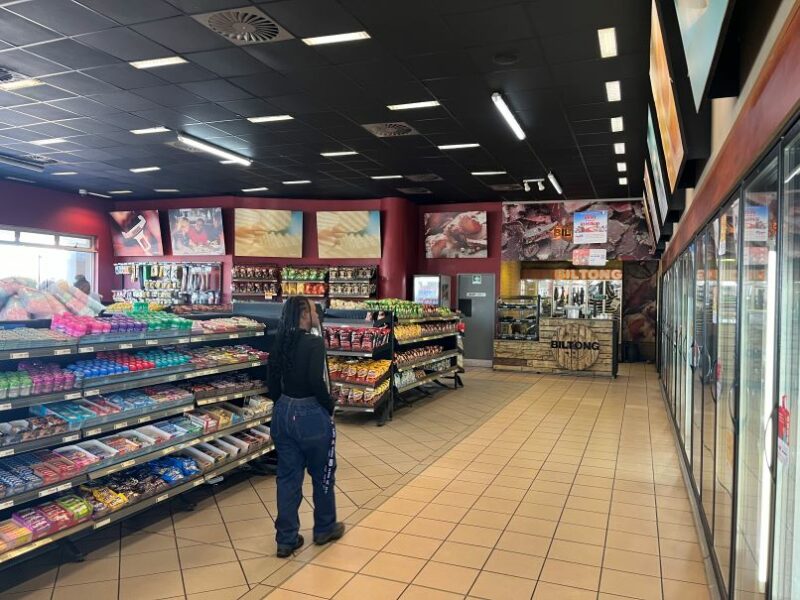
Arriving in Limpopo on our Wildebeest hunt
Arriving in Limpopo for our wildebeest hunt, we decided to make a stop for brunch before getting stuck in at the shooting range. We stopped at the Vaalwater Hotel which is a very popular restaurant in Vaalwater. They serve exceptional kudu burgers and if you ever are in the vicinity, it is well worth the stop.
We then left for the ranch where we were going to be hunting wildebeest and unpacked and left for the shooting range. As it was Sam’s first hunt, we expected to take our time at the shooting range as it was also a rife that she was unfamiliar with. She borrowed a 7mm Remington Magnum, a night force scope and a suppressor. It was loaded with 175gr Hornady ELD-X
There is a rumour or saying that generally women shoot really well, but I was gobsmacked at how awesome Samantha’s shooting was. Her grouping was dead on the money and unlike so many other hunters that I have come across she did not flinch at all!! So, we ended up not having to spend very much time at the shooting range at all! We then headed off to go inspect the hide that she would be hunting the wildebeest from. It was a temporary blind made out of tree branches and brush and had enough space inside for two chairs with shade cloth over the top (for protection from our African sun!) So, hide inspected and approved we went back to camp for an awesome dinner, a few drinks and a hot shower.
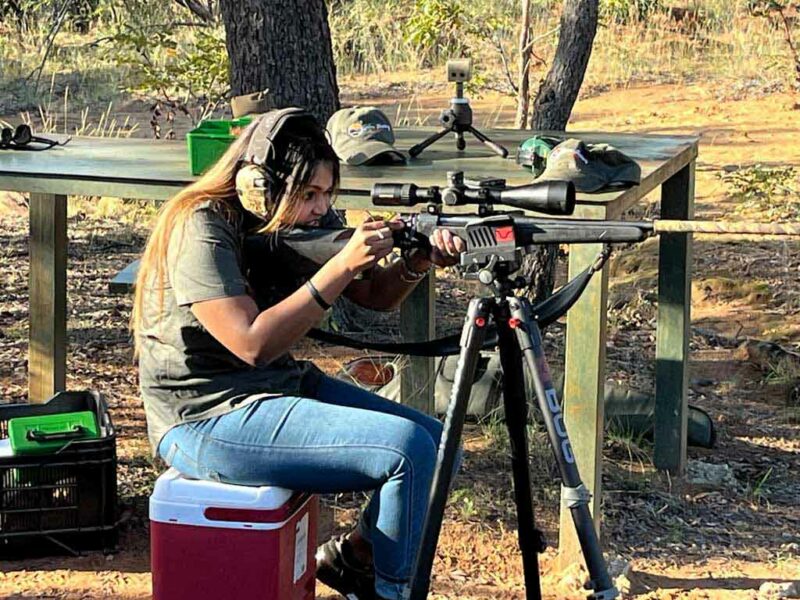
Shot Placement on a Wildebeest
Sitting round the dinner table we went into great detail on wildebeest shot placement.
Shot placement is exceptionally important, especially on a Wildebeest Hunt as these animals are renowned for their hardiness and they seldom go down easily. The ideal shot would be a broadside presentation a third of the way up the body. It is important to remember that the hump sometimes encourages hunters to aim a little too high and this would then miss the heart and end up in a very aggressive and extremely dangerous wounded wildebeest. The broadside shot is the one to wait for as it has the best chance of hitting the heart. The frontal shot is not recommended.
Blue Wildebeest are one of Africa’s toughest antelope and make for a very challenging hunt. Blue Wildebeest have a nickname “the poor mans Buffalo” a well-deserved nickname as they are very tough and can take a lot of punishment before they go down. Although they are not in any way related to the Cape Buffalo, Blue wildebeest are part of the antelope family and are not bovines even though they possess certain bovine characteristics, for example the Blue Wildebeest horns look similar to the horns of a female cape Buffalo. According to African tales the wildebeest is the animal that God made out of spare parts left over from making the other animals.
What is the minimum Caliber for hunting Wildebeest?
When hunting Wildebeest, I would not recommend any rifle with a caliber less than a .308 loaded with 180 grain good quality expanding tips.
As Wildebeest hunting often means taking longer shots at between 150 yards and 300 yards, a rifle with “punch” is needed. My recommendation would be a 30.06, or a 300 Win Mag shooting a flat trajectory.
When Wildebeest hunting, there is no such thing as “bring too much gun”. A .375 or even bigger will also get the job done. Remember, no matter the caliber, shot placement is critical.
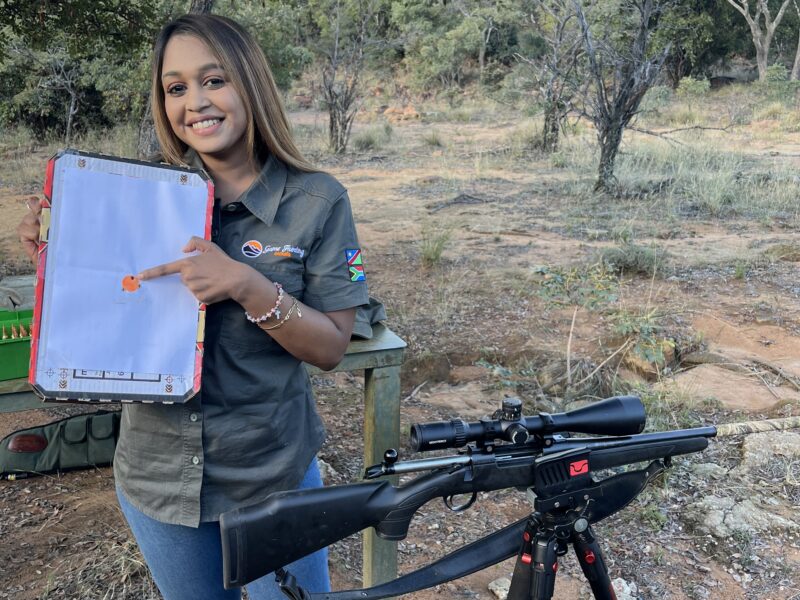
The start of Wildebeest Hunting
The next morning, we were up at sunrise had a quick cup of coffee and set out for the blind. The weather played along thank goodness as even in autumn the days can get uncomfortably hot in Limpopo, but the day started out cloudy and cool and we couldn’t have asked for better weather. Sam and the PH settled in and just as I was leaving with the bakkie (small pick up truck), I saw Blue and Golden Wildebeest in the vicinity of the blind. I did think that it wouldn’t be long before we would get a call on the radio to come and collect them, but I didn’t say anything (you don’t want to jinx it!)
On getting back to the camp I checked that the radio was working properly, and I intended to get started on making a proper full English breakfast. I put the kettle on and made more coffee and I had just finished my coffee when the radio spluttered into action… Tam Tam come in?? I picked up the radio and the PH confirmed that Sam had been successful in her wildebeest hunting and that I needed to round up the skinners and take the bakkie to go load the wildebeest.
Getting out to the wildebeest hunting spot I was very surprised to see that the wildebeest had not run very far. I asked Sam where she had hit it and from the entry would it looked like it could very well have been a direct heart shot. A perfect shot!! Anyone who has ever had the privilege (or misfortune) to hunt a wildebeest will tell you that it is an exceptionally rare occurrence for a wildebeest to go down with just one shot so quickly. There were no follow up shots needed he literally fell down dead 40 feet from where he was shot.
Perhaps it was beginners’ luck, but I don’t think so, Sam spent her time well on the range and was specific about shot placement. She did not rush her shot and was calm and confident when she took her shot.
Can you eat Wildebeest meat?
Yes you can, it is especially tasty when processed into burgers.
We loaded the wildebeest and took it back to the skinning shed, where it was skinned and gutted. We asked the skinners to please take out and show us the heart as we were convinced it had to have been a heart shot, and upon seeing the heart it was definitely a heart shot and the bullet could not have been placed any better. She did say that it was all thanks to the time and effort her PH, Keenan van Wyk, put into taking her through shot placement and the way to breath when taking the shot, she complimented him on making her feel confident. Congratulations all round and now it was time for an old hunting tradition to be blooded and eat some of the raw liver. This tradition is followed only once and only on a hunters very first animal. Sam was a star and did not flinch she ate the piece of liver without complaint and without any gagging.
The skin was sent to the taxidermy and the meat to the butcher to be processed into burgers, sausage, mince and of course biltong. The benefit of game meat is that it is very high in iron and contains higher levels of many beneficial nutrients including iron, vitamin E, Beta Carotene, Zinc Vitamin B(6) and Selenium. Selenium is an important part of our diet that we often lack and helps protect cells from damage caused by free radicals. Game meats are also often leaner than traditional meats and are a good source of protein. Additionally, some game meats like venison have been found to have a higher ratio of healthy unsaturated fats compared to saturated fats. Perhaps the biggest health benefit of game meat is that it is raised with no added hormones and no antibiotics. Hunting wild game helps to control populations of certain animals and prevent overgrazing, which can be a problem in some areas. This makes it a more sustainable source of meat compared to traditional farming methods, which can put a strain on natural resources.
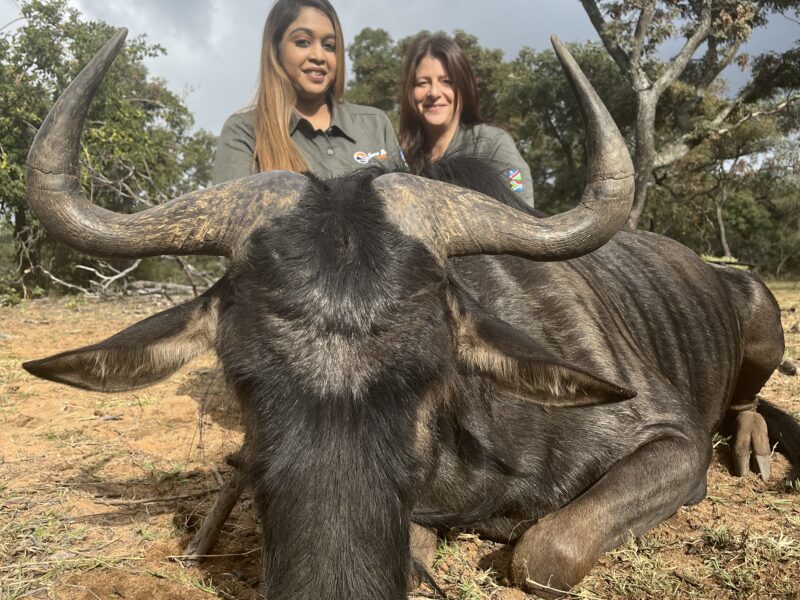
First time wildebeest hunting
Many would argue that this hunt could have gone very differently and that a blue wildebeest is not an ideal choice for a first-time hunter, and they would not be wrong. A blue wildebeest is an incredibly tough animal, and it is very very rare for them to go down without a fight or at least a good run resulting in having to track them. Tracking a wounded wildebeest is also extremely dangerous as they do become very aggressive and dangerous when wounded. There was an incident in 2013 where a farmer and his son were killed by wildebeest and the mother and daughter were seriously injured but survived.
Of course, these kind of stories we only told her once she had successfully hunted her wildebeest and we definitely did not share any horror stories of wounding a wildebeest and having to walk for days to try and find it or even worse not finding it at all! No these stories (and we all have them, sometimes from personal experience) we kept for round the fire after the successful wildebeest hunting, which I think made Samantha all the more grateful that her shot placement was on the money and her Wildebeest hunt went accordingly to plan. A hunt to remember and cherish.
T. van Wyk
